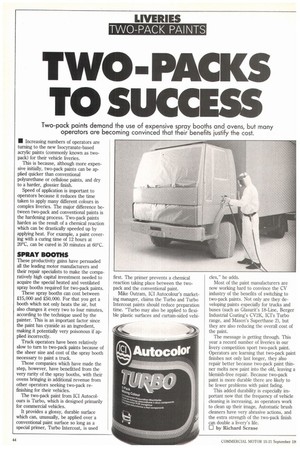TWO PACKS TO SUCCESS
Page 38

If you've noticed an error in this article please click here to report it so we can fix it.
Two-pack paints demand the use of expensive spray booths and ovens, but many operators are becoming convinced that their benefits justify the cost.
• Increasing numbers of operators are turning to the new Isocyranate-based acrylic paints (commonly known as twopack) for their vehicle liveries.
This is because, although more expensive initially, two-pack paints can be applied quicker than conventional polyurethane or cellulose paints, and dry to a harder, glossier finish.
Speed of application is important to operators because it reduces the time taken to apply many different colours in complex liveries. The major difference between two-pack and conventional paints is the hardening process. Two-pack paints harden as the result of a chemical reaction which can be drastically speeded up by applying heat. For example, a paint covering with a curing time of 12 hours at 20°C, can be cured in 30 minutes at 60°C.
SPRAY BOOTHS
These productivity gains have persuaded all the leading motor manufacturers and their repair specialists to make the comparatively high capital investment needed to acquire the special heated and ventilated spray booths required for two-pack paints.
These spray booths can cost between 15,000 and £50,000. For that you get a booth which not only heats the air, but also changes it every two to four minutes, according to the technique used by the painter. This is an important factor since the paint has cyanide as an ingredient, making it potentially very poisonous if applied incorrectly.
Truck operators have been relatively slow to turn to two-pack paints because of the sheer size and cost of the spray booth necessary to paint a truck.
Those companies which have made the step, however, have benefitted from the very rarity of the spray booths, with their ovens bringing in additional revenue from other operators seeking two-pack refinishing for their vehicles.
The two-pack paint from ICI Autocolours is Turbo, which is designed primarily for commercial vehicles.
It provides a glossy, durable surface which can, unusually, be applied over a conventional paint surface so long as a special primer, Turbo Intercoat, is used first. The primer prevents a chemical reaction taking place between the twopack and the conventional paint.
Mike Outram, ICI Autocolour's marketing manager, claims the Turbo and Turbo Intercoat paints should reduce preparation time. "Turbo may also be applied to flexible plastic surfaces and curtain-sided vehi des," he adds.
Most of the paint manufacturers are now working hard to convince the CV industry of the benefits of switching to two-pack paints. Not only are they developing paints especially for trucks and buses (such as Glasurit's 18-Line, Berger Industrial Coating's CV2K, ICI's Turbo range, and Mason's Superthane 2), but they are also reducing the overall cost of the paint.
The message is getting through. This year a record number of liveries in our livery competition sport two-pack paint. Operators are learning that two-pack paint finishes not only last longer, they also repair better because two-pack paint thinner melts new paint into the old, leaving a blemish-free repair. Because two-pack paint is more durable there are likely to be fewer problems with paint fading.
This added durability is especially important now that the frequency of vehicle cleaning is increasing, as operators work to clean up their image, Automatic brush cleaners have very abrasive actions, and the extra strength of the two-pack finish can double a livery's life, 0 by Richard Scrase






























































